MENU
The Electronic Scholarly Publishing Project: Providing access to classic scientific papers and other scholarly materials, since 1993. More About: ESP | OUR CONTENT | THIS WEBSITE | WHAT'S NEW | WHAT'S HOT
Comparative Timelines
The ESP Timeline (one of the site's most popular features) has been completely updated to allow the user to select (using the timeline controls above each column) different topics for the left and right sides of the display.
Select:
New Left Column
New Left Column
Dates
Decade
New Right Column
New Right Column
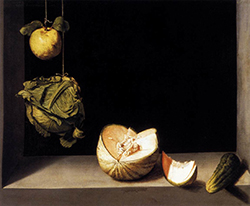 Painting by Juan Sánchez Cotán: Still Life With Quince, Cabbage, Melon, and Cucumber
Painting by Juan Sánchez Cotán: Still Life With Quince, Cabbage, Melon, and Cucumber
1600
(no entry for this year)
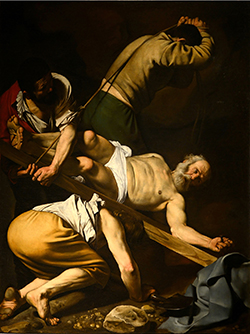 Painting by Caravaggio: Crucifixion of Saint Peter was painted for the Cerasi Chapel of Santa Maria del Popolo in Rome. Across the chapel is a second Caravaggio work depicting the Conversion of Saint Paul on the Road to Damascus (1601). On the altar between the two is an Assumption of the Virgin Mary by Annibale Carracci. The painting depicts the martyrdom of St. Peter by crucifixion Peter asked that his cross be inverted so as not to imitate his God, Jesus Christ, hence he is depicted upside down. The large canvas shows Ancient Romans, their faces shielded, struggling to erect the cross of the elderly but muscular apostle. Peter is heavier than his aged body would suggest, and his lifting requires the efforts of three men, as if the crime they perpetrate already weighs on them.
Painting by Caravaggio: Crucifixion of Saint Peter was painted for the Cerasi Chapel of Santa Maria del Popolo in Rome. Across the chapel is a second Caravaggio work depicting the Conversion of Saint Paul on the Road to Damascus (1601). On the altar between the two is an Assumption of the Virgin Mary by Annibale Carracci. The painting depicts the martyrdom of St. Peter by crucifixion Peter asked that his cross be inverted so as not to imitate his God, Jesus Christ, hence he is depicted upside down. The large canvas shows Ancient Romans, their faces shielded, struggling to erect the cross of the elderly but muscular apostle. Peter is heavier than his aged body would suggest, and his lifting requires the efforts of three men, as if the crime they perpetrate already weighs on them.
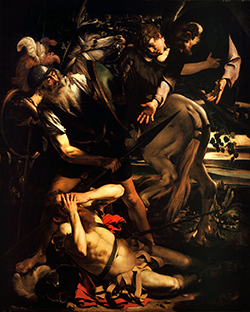 Painting by Caravaggio: The Conversion of St. Paul records the moment when Saul of Tarsus, on his way to Damascus to annihilate the Christian community there, is struck blind by a brilliant light and hears the voice of Christ saying, "Saul, Saul, why persecutest thou me?...And they that were with me saw indeed the light, and were afraid, but they heard not the voice..." (Acts 22:6-11). Elsewhere Paul claims to have seen Christ during the vision, and it is on this basis that he grounds his claim be recognised as an Apostle: "Have I not seen Jesus Christ our Lord?" (I Corinthians 9:1). Caravaggio biographer Helen Langdon describes style of Conversion as "an odd blend of Raphael and clumsy rustic realism," but notes how the composition, with its jagged shapes and irrational light which licks out details for their dramatic impact, creates "a sense of crisis and dislocation [in which] Christ disrupts the mundane world."
Painting by Caravaggio: The Conversion of St. Paul records the moment when Saul of Tarsus, on his way to Damascus to annihilate the Christian community there, is struck blind by a brilliant light and hears the voice of Christ saying, "Saul, Saul, why persecutest thou me?...And they that were with me saw indeed the light, and were afraid, but they heard not the voice..." (Acts 22:6-11). Elsewhere Paul claims to have seen Christ during the vision, and it is on this basis that he grounds his claim be recognised as an Apostle: "Have I not seen Jesus Christ our Lord?" (I Corinthians 9:1). Caravaggio biographer Helen Langdon describes style of Conversion as "an odd blend of Raphael and clumsy rustic realism," but notes how the composition, with its jagged shapes and irrational light which licks out details for their dramatic impact, creates "a sense of crisis and dislocation [in which] Christ disrupts the mundane world."
1601
(no entry for this year)
(no entry for this year)
1602
Ulisse Aldrovandi publishes De Animalibus Insectis.
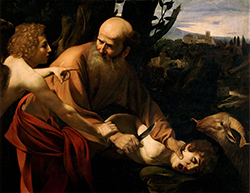 Painting by Caravaggio: Sacrifice of Isaac The Sacrifice of Isaac is the title of two paintings from c. 1598 - 1603 depicting the sacrifice of Isaac. The paintings could be painted by the Italian master Caravaggio (1571 1610) but there is also strong evidence that they may have been the work of Bartolomeo Cavarozzi, a talented early member of the Caravaggio following who is known to have been in Spain about 1617-1619. The second Sacrifice of Isaac is housed in the Uffizi Gallery, Florence. According to the early biographer Giovanni Bellori, Caravaggio painted a version of this subject for Cardinal Maffeo Barberini, the future Pope Urban VIII, and a series of payments totalling one hundred scudi were made to the artist by Barberini between May 1603 and January 1604. Caravaggio had previously painted a Portrait of Maffeo Barberini, which presumably pleased the cardinal enough for him to commission this second painting. Isaac has been identified as Cecco Boneri, who appeared as Caravaggio's model in several other pictures. Recent X-ray analysis showed that Caravaggio used Cecco also for the angel, and later modified the profile and the hair to hide the resemblance.
Painting by Caravaggio: Sacrifice of Isaac The Sacrifice of Isaac is the title of two paintings from c. 1598 - 1603 depicting the sacrifice of Isaac. The paintings could be painted by the Italian master Caravaggio (1571 1610) but there is also strong evidence that they may have been the work of Bartolomeo Cavarozzi, a talented early member of the Caravaggio following who is known to have been in Spain about 1617-1619. The second Sacrifice of Isaac is housed in the Uffizi Gallery, Florence. According to the early biographer Giovanni Bellori, Caravaggio painted a version of this subject for Cardinal Maffeo Barberini, the future Pope Urban VIII, and a series of payments totalling one hundred scudi were made to the artist by Barberini between May 1603 and January 1604. Caravaggio had previously painted a Portrait of Maffeo Barberini, which presumably pleased the cardinal enough for him to commission this second painting. Isaac has been identified as Cecco Boneri, who appeared as Caravaggio's model in several other pictures. Recent X-ray analysis showed that Caravaggio used Cecco also for the angel, and later modified the profile and the hair to hide the resemblance.
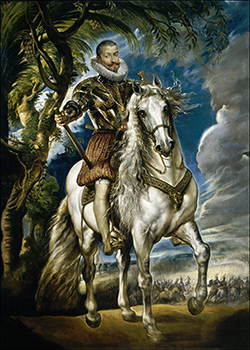 Painting by Peter Paul Rubens: The Duke of Lerma on Horseback. When he visited the Spanish Court for the first time, Rubens (still in his twenties) used this picture to display his talents and to make his mark. It has already many elements of his mature Baroque style, which would have been novel and striking to his viewers. The way in which the horse seems to surge forward towards the spectator - an effect engineered by the low viewpoint and lack of balancing elements in the foreground, and recalling the techniques of Caravaggio - was spectacular, and broke with the traditional profile of equestrian portraits. Other devices used to enhance the spectacle were the eccentric colouring, the tempestuous lighting, and the rather disquieting energy of the horse's hair and the trees' foliage.
Painting by Peter Paul Rubens: The Duke of Lerma on Horseback. When he visited the Spanish Court for the first time, Rubens (still in his twenties) used this picture to display his talents and to make his mark. It has already many elements of his mature Baroque style, which would have been novel and striking to his viewers. The way in which the horse seems to surge forward towards the spectator - an effect engineered by the low viewpoint and lack of balancing elements in the foreground, and recalling the techniques of Caravaggio - was spectacular, and broke with the traditional profile of equestrian portraits. Other devices used to enhance the spectacle were the eccentric colouring, the tempestuous lighting, and the rather disquieting energy of the horse's hair and the trees' foliage.
1603
(no entry for this year)
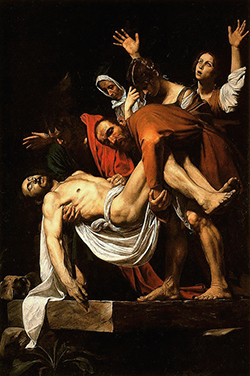 Painting by Caravaggio: The Entombment of Christ, one of the artist's most admired altarpieces, was created for the second chapel on the right in Santa Maria in Vallicella (the Chiesa Nuova), a church built for the Oratory of Saint Philip Neri. A copy of the painting is now in the chapel, and the original is in the Vatican Pinacoteca. The painting has been copied by artists as diverse as Rubens, Fragonard, Géricault and Cézanne.
Painting by Caravaggio: The Entombment of Christ, one of the artist's most admired altarpieces, was created for the second chapel on the right in Santa Maria in Vallicella (the Chiesa Nuova), a church built for the Oratory of Saint Philip Neri. A copy of the painting is now in the chapel, and the original is in the Vatican Pinacoteca. The painting has been copied by artists as diverse as Rubens, Fragonard, Géricault and Cézanne.
1604
(no entry for this year)
(no entry for this year)
1605
(no entry for this year)
(no entry for this year)
1606
(no entry for this year)
(no entry for this year)
1607
(no entry for this year)
(no entry for this year)
1608
(no entry for this year)
(no entry for this year)
1609
(no entry for this year)
ESP Quick Facts
ESP Origins
In the early 1990's, Robert Robbins was a faculty member at Johns Hopkins, where he directed the informatics core of GDB — the human gene-mapping database of the international human genome project. To share papers with colleagues around the world, he set up a small paper-sharing section on his personal web page. This small project evolved into The Electronic Scholarly Publishing Project.
ESP Support
In 1995, Robbins became the VP/IT of the Fred Hutchinson Cancer Research Center in Seattle, WA. Soon after arriving in Seattle, Robbins secured funding, through the ELSI component of the US Human Genome Project, to create the original ESP.ORG web site, with the formal goal of providing free, world-wide access to the literature of classical genetics.
ESP Rationale
Although the methods of molecular biology can seem almost magical to the uninitiated, the original techniques of classical genetics are readily appreciated by one and all: cross individuals that differ in some inherited trait, collect all of the progeny, score their attributes, and propose mechanisms to explain the patterns of inheritance observed.
ESP Goal
In reading the early works of classical genetics, one is drawn, almost inexorably, into ever more complex models, until molecular explanations begin to seem both necessary and natural. At that point, the tools for understanding genome research are at hand. Assisting readers reach this point was the original goal of The Electronic Scholarly Publishing Project.
ESP Usage
Usage of the site grew rapidly and has remained high. Faculty began to use the site for their assigned readings. Other on-line publishers, ranging from The New York Times to Nature referenced ESP materials in their own publications. Nobel laureates (e.g., Joshua Lederberg) regularly used the site and even wrote to suggest changes and improvements.
ESP Content
When the site began, no journals were making their early content available in digital format. As a result, ESP was obliged to digitize classic literature before it could be made available. For many important papers — such as Mendel's original paper or the first genetic map — ESP had to produce entirely new typeset versions of the works, if they were to be available in a high-quality format.
ESP Help
Early support from the DOE component of the Human Genome Project was critically important for getting the ESP project on a firm foundation. Since that funding ended (nearly 20 years ago), the project has been operated as a purely volunteer effort. Anyone wishing to assist in these efforts should send an email to Robbins.
ESP Plans
With the development of methods for adding typeset side notes to PDF files, the ESP project now plans to add annotated versions of some classical papers to its holdings. We also plan to add new reference and pedagogical material. We have already started providing regularly updated, comprehensive bibliographies to the ESP.ORG site.
ESP Picks from Around the Web (updated 06 MAR 2017 )
Old Science

Weird Science

Treating Disease with Fecal Transplantation
Fossils of miniature humans (hobbits) discovered in Indonesia

Dinosaur tail, complete with feathers, found preserved in amber.
Astronomy

Mysterious fast radio burst (FRB) detected in the distant universe.